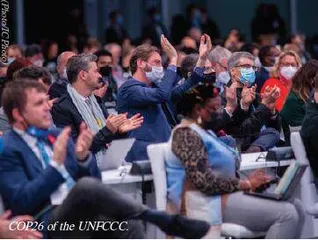Climate Governance and Sustainable Development
作者: Zhang Haibin

Climate change is one of the most severe challenges faced by all countries in the world today. The international community is following closely the development of global climate governance. It is generally believed that the United Nations Conference on the Human Environment held in 1972 marked the beginning of global environment governance, and that the initiation of global climate negotiations under the framework of the UN was the start of global climate governance. In the past three decades, global climate governance had continued to evolve and develop and has made many positive progresses. Seen as a mirror of global governance, global climate governance has become an important item high on the agenda of human development and a key area for international cooperation. To make new headway in global climate governance, it is crucial to improve the global climate governance system and remain committed to multi-layer cooperation under multilateral framework.
HISTORY AND FEATURES OF GLOBAL CLIMATE GOVERNANCE
On December 21, 1990, resolution 45/212 Protection of Global Climate for Present and Future Generations of Mankind was adopted by the UN General Assembly during its 45th session. It was decided that an Intergovernmental Negotiating Committee (INC) should be established for setting up an effective framework convention on climate change. This marked the beginning of global climate negotiations and governance. In May 1992, the United Nations Framework Convention on Climate Change (UNFCCC) was adopted by the INC after five rounds of negotiations which started in February 1991. The UNFCCC was opened for signature in June 1992 at the UN Conference on Environment and Development and entered into forth in March 1994.
The UNFCCC laid a solid foundation for international cooperation on coping with climate change. It underpinned and marked the beginning of the era for global climate governance. The Kyoto Protocol in 1997 and the Paris Agreement in 2015, which were reached under the framework of the UNFCCC, are considered two landmark accomplishments in global climate governance. Taking a look at the history of global climate governance, we can see the progresses made and some key features.
First, the objectives of global climate governance have become clearer. With more measures taken to cope with climate change, the international community has set clearer climate objectives. As is stated in Article 2 of the UNFCCC, the ultimate climate objective is to achieve stabilization of greenhouse gas concentrations in the atmosphere at a level that would prevent dangerous anthropogenic interference with the climate system. Article 2 in the Paris Agreement specifies that global climate actions should be strengthened by holding the increase in the global average temperature to well below 2℃ above pre-industrial levels and pursuing efforts to limit the temperature increase to 1.5℃ above pre-industrial levels, recognizing that this would significantly reduce the risks and impacts of climate change. The objectives in the Paris Agreement are quantitative and stated more specifically, as they are developed on the basis of the overall objective in the UNFCCC.
Second, the principles of global climate governance have undergone constant changes and adjustments. The UNFCCC set as the basic principles of global climate cooperation the precautionary principle, the principle of fairness, common but differentiated responsibility, and respective capabilities. Later in the Paris Agreement, the common but differentiated responsibility principle was complemented with the new statement of “in the light of different national circumstances”, which was conducive to more efficient cooperation on a broader scale. Another trend worth noticing was that the principle of sustainable development has been reinforced in the process of global climate governance.
Third, the means to emission reduction has witnessed major shifts. The Kyoto Protocol which came into effect in 2005 mainly took a top-down approach in assigning emission reduction targets. As the situation evolved, however, the role and influence of different countries in global climate governance changed significantly and it became much more difficult to reach compromises among interests of all sides. The top-down model thus became obsolete. When the countries reached the Paris Agreement in 2015, they mainly adopted a bottom-up approach of nationally determined contributions.
Fourth, a multi-layer, multi-dimensional global climate governance system with strong resilience has been gradually formed over the years. Since the initiation of the UN climate negotiations, the fundamental structure of global climate governance has constantly evolved and has now become a multi-layer, multi-dimensional governance system with state-level, sub-state-level, and non-state players, and with the UNFCCC, the Kyoto Protocol and Paris Agreement at the center. The current system has shown great resilience, as it has withstood the impact of major crises such as the 2008 Financial Crisis, the withdrawal of the U.S. Trump administration in 2017, and the COVID-19 pandemic.
Fifth, science and policy-making have become more closely-knit. Science and technology play a crucial role in global climate governance. All six IPCC climate change assessment reports have had an important influence on the process of global climate negotiations, which then in turn charted the course for the scientific assessment of climate change. It is worth mentioning that the development of green low-carbon technology led to a dramatic decrease in emission reduction costs, which promoted the process of global climate negotiations. The results of the negotiations in turn promoted the innovation and development of green low-carbon technology.